Speech Why Financial Stability Matters, and What We Can Do About It

Luci Ellis
[*]
Head of Financial Stability Department
Address to the University of Adelaide
Adelaide –
- Audio 28.87MB
- Q&A Transcript
Thank you to the University of Adelaide Economics Department for the invitation to speak to this group. It is always a pleasure to come to Adelaide.
This evening, I thought it would be worth taking a step back and reflecting on some of the lessons of the crisis and the post-crisis period. Certainly there are a lot of things I have learnt in my time so far as head of Financial Stability department.
I started in this role on 20 October 2008, just a few weeks after Lehman Brothers – and a string of other institutions – had failed.
As you can imagine, those first few months were quite frantic. The Australian financial system and economy were not doing too badly, but there was always a possibility that investor panic could lead to a run on Australian institutions. After some governments overseas guaranteed the banks in their countries, Australia had little choice but to follow suit. The financial stability team at the Bank were heavily involved both in designing the guarantee, and putting it in place. (I personally processed several applications.)
The subsequent years have been just as busy. First came the wave of regulatory reform, directed by the G20. Australia's role in the international standard-setting process expanded. Before 2009, the Australian authorities were not even members of the Basel Committee on Banking Supervision (BCBS). Now both APRA and the RBA have seats at the table, and the Bank has had to get more involved with the details of prudential standard-setting than we did before the crisis.
Once the international standards were agreed, next came the wave of implementation. There is still some work to do in some areas, but many of the big pieces of the reform agenda are in place in most countries, or soon will be.
Now the third wave of post-crisis work is to assess that implementation. Almost all of the main reform initiatives from groups such as the G20 are soon followed up by a cross-country peer review, to check how countries have implemented the reforms, and the time lines. This comes on top of the usual rounds of international scrutiny, such as the IMF Financial Sector Assessment Program (FSAP), which Australia went through in 2012.[1]
I think policymakers around the world have learnt a lot over the past six years. I'd like to spend some time this evening reflecting on some of the lessons that I think are most important.
The Right Question
The first lesson is that asking the right question is half the battle. We need to ask: what problem are we trying to solve? Central banks and supervisors are mandated to promote financial stability, or some variant on those words. Remarkably, there has not been much consensus in how to define that policy goal. For some, it is about preserving market functioning; for others, it is about avoiding undesirable movements in asset prices or exchange rates.
In Australia, at least, we focus on the risk of a disruption in the financial system so severe that it materially harms the real economy. We don't try to pre-specify the form that disruption might take. We focus on the ultimate goal.
Recent research in Europe using household survey data shows that people don't actually care about financial imbalances for their own sake (Stracca 2014). They care about incomes and unemployment – about output. At a deep level, a financial stability mandate is really an output mandate. We want to avoid financial instability because it reduces output and harms human welfare through that channel. History shows that downturns are worse, and recoveries slower, when there has been a banking or broader financial crisis.[2]
Our policies should, after all, improve the welfare of society. That is one of the Bank's legislated mandates. Research like this tells us something important about how we pursue those ends. As policymakers, we do not – should not – care about asset prices or credit for their own sakes. Nor do we care if banks are safe just for the sake of having safe banks. Rather, we care whether a bank that did fail might do so in a way that harms the real economy. Banks are firms, and firms do not love, or hurt – or vote. But people do, and people are harmed by the recessions, by the loss of their life savings, by all of the things that financial instability inflicts upon the world. That is why we promote the stability of the financial system and the firms within it, but do not pursue a ‘no-failures’ regime. We are not trying to eliminate all risk, and we are not mandated to serve the interests of some firms ahead of society.
Society's welfare might therefore not be best served by policies that seek to minimise variability in property markets, or asset prices more broadly, or some measure of credit. It might be how it works out in practice, perhaps. But our objectives and our policy practice must be founded on the welfare of society, as best we understand it.
And that comes back to output. It comes back to the fact that financial instability is harmful to output and employment. Property markets, asset prices, credit and the array of other variables we look at in financial stability circles are not objectives. They are information variables. They are useful, but we should not define our performance in terms of having control over these variables. What matters more are the risk of a crisis and the severity of the resulting effects on output.
Behind those output figures, there is a real human cost to financial instability. The recent crisis was a standout example of this. Unemployment rates increased dramatically in a number of countries. People lost their livelihoods, their savings, their homes. Graph 1 shows the share of US mortgages that were behind on their repayments, as well as the separate group subject to foreclosure proceedings. The sum of the two peaked around 9 per cent. Even when you factor in the people who owned their homes outright (without a mortgage), that means a significant fraction of the population was in distress. The total number of American families who actually lost their homes over this period ran into the millions.
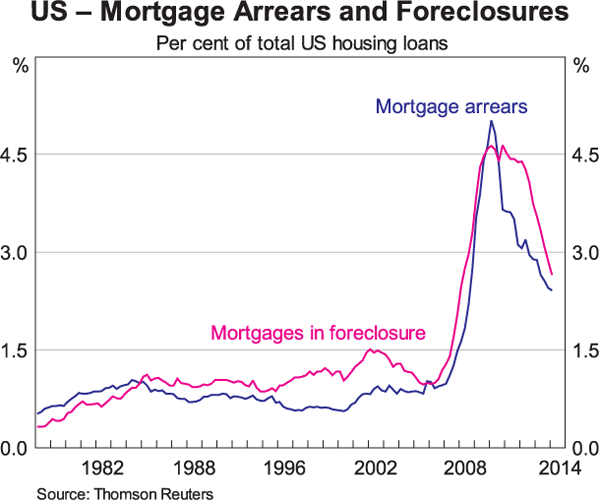
Financial instability is also contagious. Many of the people who lost their jobs or their homes in the years following the crisis had not contributed to the build-up of risk that sparked the crisis. They were simply hit by the ensuing recession. The economic effects of the crisis can also spread to countries that had not been part of the financial crisis itself, such as many in the Asian region. You can see this in Graph 2, which shows the sharp fall in industrial production in Asia following the crisis. I find it remarkable that the declines are larger, and longer-lasting, than the later downward spikes associated with natural disasters: the earthquake and tsunami in Japan, and flooding in Thailand.
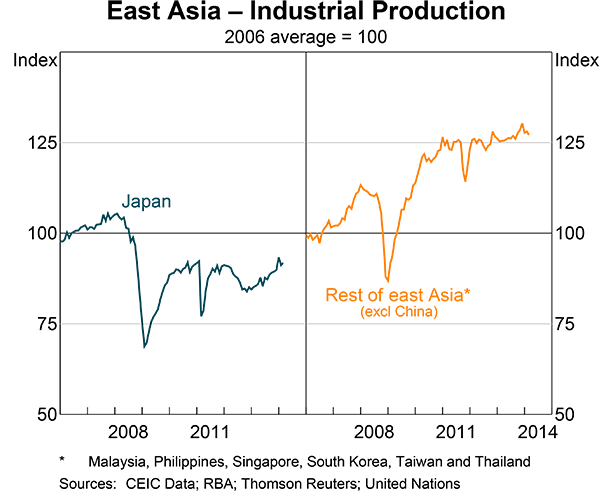
So the problem we are trying to solve is to reduce the risk and cost of financial instability. We should therefore seek to reduce the build-up of risk, which might or might not manifest as a boom in asset prices and credit. We should also seek to make the system resilient to the shocks that occur from time to time, so that the system does not end up in crisis following every unexpected event.
In framing the objectives of financial stability policy in this way, it becomes clear that rapid developments in property markets, other asset prices and credit can be – but are not always – a signal that risks to financial stability are building. I do not underestimate the challenge of disentangling this signal from the normal transmission mechanism of monetary policy.
Asking the right question about our goal turns out to have been less obvious than you might imagine. A lot of the pre-crisis debate about financial stability policy was framed around the question, ‘should monetary policy prick bubbles?’. The first problem with this question is that it assumed what the policy instrument should be. Monetary policy might be part of the solution, but you should not assume it is.
The second problem with the question was that it assumed that asset price bubbles were the crux of the policy problem. The debate could then be diverted into discussions about whether you could identify bubbles, how you could do that, and whether you could pop them before they become dangerously large – again, assuming that you could do that without too many bad side effects.
I have two reservations about framing the policy problem in this way. The first is that the policy debate then ends up being about my model versus yours. The estimate of the bubble component of prices is only as good as the model of fundamentals. And getting bogged down in arguments about models is a recipe for inaction.
Another problem with this framing is that, actually, a bubble in asset prices is not even necessary in order for a financial stability problem to occur later on. This is particularly so in property markets, where supply is inherently more or less fixed, because most of it has already been built. In that case, large price and construction cycles can happen that appear completely consistent with fundamentals.
Perhaps this can be best illustrated with a data series from outside the property sector (Graph 3). This graph shows the Baltic Dry Index. It summarises the average price of bulk shipping services, as opposed to container shipping. As you can see, there are a number of drawn-out price booms over several years that subsequently crash. This pattern is most noticeable in the past decade or so, but taking the lower base into account, the price cycle around 1994 was also very large.
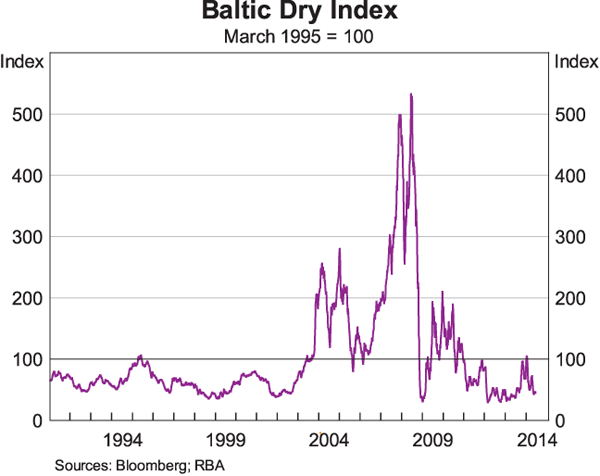
I struggle to imagine how one could have a bubble in shipping services. They are a service, not an asset that can be stored and on-sold. What we see here is no bubble, but exactly the kind of boom-bust price dynamics that can occur when the underlying supply is more or less fixed. As with property, it takes time to build ships, and the annual production of ships is usually only a small fraction of those currently operating. So an increase in demand, because of a boom in world trade, eventually hits the vertical part of the short-run supply curve, where there simply are no more spare ships. Shipbuilders respond, but it takes a while for the new ships to be completed. Prices fall, and if those new ships come on line at the same time as world trade is weakening, as it did in 2008–09, then the size of that price fall can be dramatic.
Property markets show the same dynamic. We can see from this graph that large price cycles can happen even while prices stay in line with rents (Graph 4). And of course, property, broadly defined, is much more important to the Australian financial system than the shipping industry is.[3]
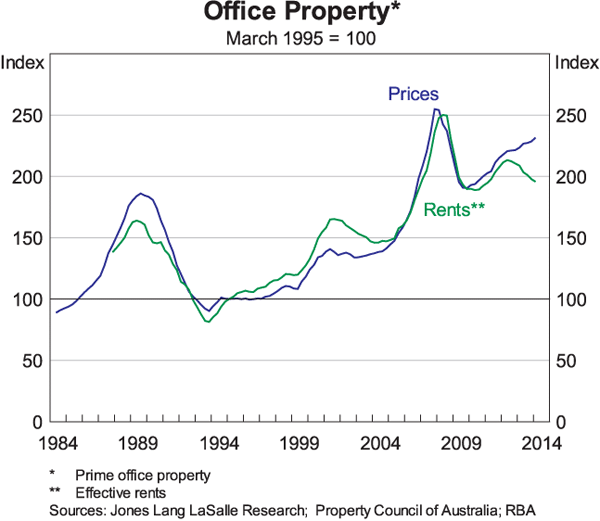
Now consider that in many markets of this kind – including property as well as shipping – there is a lot of leverage. When prices fall, entities in these markets can become distressed. Their spending falls; that would affect the real economy directly. And if they have a lot of debt, and default on it, there can be further repercussions through the financial system.
So asset price bubbles might be one development to watch for, but if we are asking the right policy question, we have to look at much more than that.
In framing the objectives of financial stability policy as something other than the absolute level of some asset price, I am not saying that asset prices do not matter to social welfare. For example, whenever housing prices boom, people worry that housing has become unaffordable. Of course, if prices are rising, it must be that someone can afford those prices. If they are motivated by speculative expectations, though, prices can run ahead of levels that can be sustained in the longer term. So there can be a financial stability angle to those concerns, if a future fallout is likely to harm the real economy, either directly or via distress in the financial system.
But the real policy concern here is that other people get priced out. It is fundamentally a question of distribution, particularly intergenerational distribution. This is not in the remit of financial stability policy, and the two goals should not be conflated. But we should be mindful of this equally legitimate goal of public policy, which is to ensure that everyone can access appropriate shelter that they can reasonably afford. Sometimes this goal mutually supports the goal of financial stability. But as we saw in the US housing meltdown, if you get the policy response to an affordability issue wrong, the consequences for financial stability can be dire.
The Multiple Facets
The second important lesson is that financial stability analysis and policy are multifaceted. It requires more than one approach to analysis and more than one policy instrument to respond. As such, it will often require more than one agency or arm of government to work together.
I came to this role from the monetary policy side of the Bank. Having seen both sides, it is clear to me that financial stability policy is a bit different.
Monetary policy reminds me of this picture (Figure 1, left side). The sea might be stormy; the view ahead might be obscured by fog; the timing of the waves might be unpredictable. Even with a lot of information, you might only have a vague idea of where you are right now. But at least you know roughly where you are going – you have a single target – and you have a single instrument that you know usually works, to steer you in approximately the right direction.
Financial stability policy looks rather different (Figure 1, right side).


When thinking about risks in the financial system, there seem to be a lot of moving parts. It isn't obvious how they all connect. And there seem to be many places where you can intervene and have some effect – though perhaps not the one you were expecting!
That complexity has implications for the approach to analysis. Rather than try to estimate a single model of fundamentals and look for bubbles, look at all the evidence and try to piece together the story. It is a bit like the work of an archaeologist: you don't have complete information, but somewhere in the shards of pottery and other bits and pieces, you can make out a coherent explanation that fits with all the pieces you have.
That complexity also has implications for the appropriate policy framework. Because the risks can come from so many different sources, it does not make sense to restrict oneself to a single policy tool in response, or even a small collection of them. In fact, it is probably a mistake to focus solely on policy tools for responding to current risks: in other words, policies of waiting until you have a problem and then responding. I think it is worth devoting more time to thinking about the design of the overall policy framework, and how that might support financial stability.
For a start, it is very hard to have a good financial stability outcome without the right macroeconomic policy framework. If we abstract from the recent US crisis for a moment and think about the broader run of crises, we can see how important it is to get the broader macro and fiscal frameworks right. In emerging and middle-income countries, foreign currency borrowing and other cross-border issues are much more of a concern than whatever is going on in mortgage markets, which are often quite small in these countries.
Australia is known as a country that has been able to use a fully floating exchange rate to absorb shocks from abroad (Rajan 2014). More fundamentally, a fully floating exchange rate regime means that monetary policy can be set according to domestic conditions, and balance of payments surpluses do not expand money and credit. With a floating exchange rate and a sufficiently forward-looking approach to inflation targeting, it is less likely that monetary policy settings will unleash a period of overly exuberant asset price and credit growth. Financial markets and asset prices respond more quickly to monetary policy than output and inflation do. So we should not be surprised that if interest rates are ‘too low’ for the domestic economy, the financial stability effects of that arise before the inflation effects.
It takes some work to get the institutions right to make it possible to float with confidence. In particular, you need deep, liquid hedging markets. This ensures that domestic entities are ultimately borrowing in the domestic currency, even if the original bond is in a foreign currency. They are both protected from the worst effects of exchange rate volatility, and given the incentive to manage FX risk. And they are not lulled into a false sense of security that the exchange rate will remain stable.
As part of the overall macro policy framework, it might help to design the tax system in a way that avoids overly rewarding leveraged speculation, particularly in property. There are often reasonable sounding rationales for things like generous deductibility of interest payments. The result is sometimes to make leveraged speculation in second-hand assets tax-preferred to investment in new income-producing assets that do not generate capital gains. These rationales need to be balanced against the costs of financial instability, as well as the more conventional concerns about resource allocation favouring speculative assets.
Calibrating the regulatory framework appropriately also helps promote financial stability. This includes the regulatory framework for consumer protection when extending credit. This area of regulation is often underappreciated. But it is an important line of defence against an extreme easing in lending standards, especially if some lenders are not prudentially supervised. In Australia, household borrowers have recourse to arbitrators and the courts if they believe they have fallen victim to predatory lending. There are certainly cases in Australia where the courts have struck down or reduced loans that the lender should not have made. That is a powerful incentive not to engage in various kinds of abuses, such as lending based on fictional incomes.
The prudential regulatory framework also needs to be calibrated appropriately. If a potentially harmful credit boom does occur, should you necessarily conclude that you need to engage in some kind of countercyclical prudential policy? Maybe not: if the overall framework is simply calibrated too loosely, the outcomes are observationally equivalent. Perhaps the whole regime just needed to be tighter, which is what the Basel 2.5 and Basel III packages achieved.
Of course, this means that the objective of the prudential regime needs to include, or at least be compatible with, promoting financial stability. If you specify the mandates of the policymakers appropriately, this need not be a problem. I will talk about this a bit more in a moment, but there is no need to constrain the mandate of prudential supervision to be the safety of individual institutions. To do so is a choice, one that has not worked out well in other countries.
Even if the overall policy framework is well designed, there could still be a build-up of risks to financial stability that one might need to respond to. Again, the system is so complex and the potential risks so diverse, that it does not make sense to restrict the policy response to one or a few different policy tools. The response is multifaceted.
The early 2000s debate about policy responses to asset price developments was mainly about how monetary policy should respond. It is still an open question. One can imagine situations where one might want policy to be a bit tighter – and inflation lower than target – for financial stability considerations. After all, monetary policy is about setting the price of credit. But as I mentioned a few moments ago, setting monetary policy according to domestic circumstances is surely the first step.
Prudential regulation and supervision can also help lean against credit excesses, and is perhaps more direct than monetary policy. It gets less attention in global policy debates, perhaps because it is in some sense invisible. You can't graph engagement with boards. You can't even see the supervisor's implied threat of using directions powers or higher capital requirements under Pillar 2. But those powers, if credible, can shape bank behaviour and risk-taking.
All this raises the question of what the central bank can do to promote financial stability, if it is not the supervisor. For a start, it has a longstanding role as liquidity provider and so-called ‘lender of last resort'. These functions are essential to the authorities’ crisis management planning and response. They also allow the Bank to gather market intelligence relevant to financial stability.
Beyond those traditional functions of central banking, the financial stability function has two tools: a telephone, and a microphone. The telephone is, of course, for calling APRA and sharing our concerns. Central banks have a concentration of analytical resources: highly skilled people accustomed to analysing economic and financial data. APRA does too, but having people with different training and expertise looking at these issues from different perspectives helps ensure that emerging risks are not missed. And if a particular risk involves parts of the financial sector that are not prudentially regulated, the central bank (or securities regulator) is likely to be better placed to join the dots.
The other policy tool, the microphone, is a reference to communication. I've used cartoons to make some of these points about financial stability policy before (Ellis 2012), and here is another one (Figure 2). The essential point is that people's expectations matter. Exposing and warning of risks can ideally change behaviour, and steer the system away from higher-risk outcomes.

At this point I should probably mention macroprudential policy. By now it should be clear that the Australian authorities' views on this supposedly new toolkit are a bit different from those in some other jurisdictions. We view macroprudential policy as something to be subsumed into the broader financial stability framework. We recognise that quantitative restrictions were already tried in the 1960s and 1970s – and didn't always work so well. And we think that it is entirely acceptable for prudential measures, macro or otherwise, to be wielded by the prudential supervisor, where they have the appropriately formulated mandate.
Of course a successful financial stability policy framework needs to operate across more than one kind of policy response. And that means it must cross several public agencies. That is another way in which financial stability policy is a multifaceted effort. These agencies need to not only coordinate, but to achieve a much deeper level of engagement. If the Australian experience is a guide, achieving close and effective engagement comes down to consistent mandates and genuine respect among equals. The rationale for carving out particular bits of the prudential framework under separate governance – which is what people mean nowadays by ‘macroprudential tools’ – appears to be that supervisors cannot be relied on to discharge their duties with system-level concerns in mind. That might be true in some countries, but not in Australia and at least some other countries. And it does not strike me as being particularly respectful of the expertise of supervisors. The last thing we would want is the situation shown in this cartoon, where the central banker, on the left, is assuming that he or she knows better than the prudential supervisor on the right (Figure 3).

The division between ‘microprudential’ supervision, narrowly focused on individual institutions, and system-wide ‘macroprudential’ supervision, never made much sense to us in Australia. You can't promote the safety of institutions without considering their environment, which includes the financial system as a whole. If the supervisory agency really is microprudential in outlook, fixing its mandate might be needed; fixing its mindset is surely equally important. As I have explained on a previous occasion, in Australia, the authorities consider macroprudential policy to be better described as a state of mind than a suite of tools (Ellis 2012). Another way of describing this is as ‘macro-prudence’ rather than macroprudential (Littrell 2013).
That state of mind informs the design of the overall prudential framework. It does not need to be restricted to periodic responses when emerging risks are detected. A good example of what this means for prudential regulation is the prudential practice guide on mortgage lending, which APRA released in draft form recently. Instead of setting out prescriptive rules, APRA's approach has been to empower bank boards to demand prudent lending policies and practices at their banks.
The Bank had flagged the release of this document in the last Financial Stability Review. While it is APRA's policy and document, naturally the Bank and APRA shared views about it during the drafting process, and we fully support what APRA is doing in this area. It is calibrating the overall framework with a view to market-wide concerns, rather than responding from time to time with specific interventions.
This is not to say that some countercyclical tightening of prudential policy settings is never warranted. But if monetary policy responds appropriately to domestic conditions, and the prudential framework is sufficiently tight and there are no leakages through public sector involvement in absorbing credit risk, the set of circumstances in which a countercyclical prudential response to a credit boom is needed is much narrower.
The Path Ahead
The third lesson I have taken from the past few years is that there is still a great deal to learn. On the policy side, there has been a great deal of experimentation with new and changed policies. Some of these are changes to the prudential framework, such as the higher capital requirements and new liquidity rules that are part of the Basel III package. The main effects of these changes are fairly predictable, in that they will make the banking system safer and more resilient. In the case of the liquidity rules, most jurisdictions had some kind of requirement; now these are going to be harmonised globally.
Some of the other policies are perhaps a little more adventurous. For example, the move to central clearing in derivatives markets will change how those markets operate. At the very least, many of the existing statistical relationships between various pieces of data can be expected to change. That is a perennial issue for analysis when there is a regime change in regulation or policy more generally.[4]
The scope for learning more is even greater on the analytical side. I think this is an exciting time for researchers and policy analysts alike.
It is far too early to present a unified framework for financial stability analysis, and it might not even be possible. Even so, we can piece together some of the important factors that we need to look at in our work (Figure 4). Essentially, we are looking at the behaviour of participants in the economy and financial system, especially the risk they are taking, as well as any rent-seeking behaviour.[5] Their behaviour is shaped by behavioural traits as well as the incentives they face, which in turn are determined by the institutional environment – tax, legal systems, regulation and developments in the rest of the world. And the combination of how people and firms behave and the shocks that they face will determine their resilience, how vulnerable they are to become distressed, and what that might mean for financial stability and the health of the real economy.
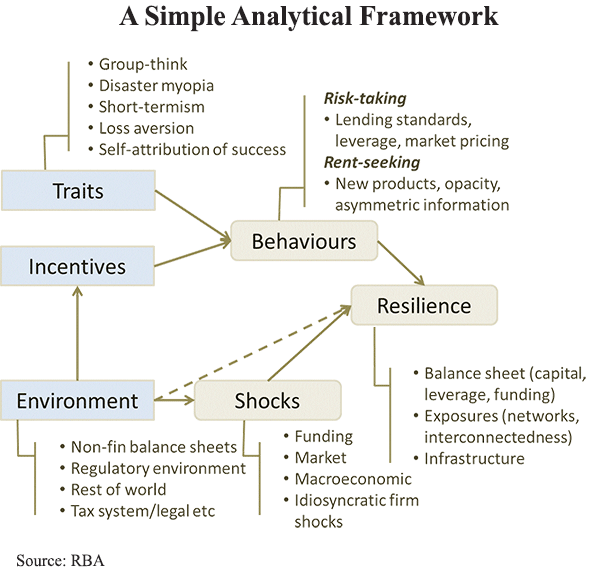
Each of these pieces of the system requires some theory to make sense of it, much of which is yet to be developed. They also require some data to track what is happening, much of which does not yet exist. Thus even as the program of post-crisis regulatory reform reaches its latter stages, our task will remain challenging and will continue to evolve.
In sum, there is still a lot to learn in this complex, multifaceted world of financial stability analysis and policy. And if asking the right question is half the battle, answering it is surely the other half. Accordingly I stand ready to at least try to answer your questions tonight.
Thank you for listening.
Endnotes
Thank you to Jessica Pratten for assistance on an earlier version of this talk. [*]
To give a flavour of the extent of this scrutiny, in the past four years, Australia has responded to around 20 reviews by the Financial Stability Board, including annual implementation monitoring exercises, thematic peer reviews and, in 2011, a specific country review of Australia. Individual standard-setters also conduct their own reviews, such as the BCBS' 2013 review of Australia's implementation of the Basel III reforms. [1]
See Cerra and Saxena (2008) and Reinhardt and Rogoff (2009). [2]
Loans to shipbuilders and shipping companies are important to banking systems in some other countries, including Germany, Greece and South Korea. Losses on these loan portfolios tend to surge periodically in similar ways to portfolios of loans for commercial real estate and property development. [3]
This is, of course, the famous Lucas (1976) Critique. [4]
I discussed these behaviours in detail in an earlier speech (Ellis 2011). [5]
Bibliography
Cerra V and S Saxena (2008), ‘Growth Dynamics: The Myth of Economic Recovery’, American Economic Review, 98(1), pp 439–457.
Ellis L (2011), ‘The Platypus Moment: Rents, Risks and the Right Responses’, Paul Woolley Centre for Capital Market Dysfunctionality Annual Conference, Sydney, 13 October.
Ellis L (2012), ‘Macroprudential Policy: A Suite of Tools or a State of Mind?’, Paul Woolley Centre for Capital Market Dysfunctionality Annual Conference, Sydney, 11 October.
Littrell C (2013), ‘Macro Prudence vs Macro-prudential Supervision’, Macquarie University Centre for Financial Risk, Sydney, 23 March. Available at <http://www.apra.gov.au/Speeches/Pages/Macro-prudence-vs-macro-prudential-supervision.aspx>.
Lucas RE (1976), ‘Econometric Policy Evaluation: A Critique’, Carnegie-Rochester Conference Series on Public Policy, 1(1), pp 19–46.
Rajan RG (2014), ‘Competitive Monetary Easing: Is it Yesterday Once More?’, Brookings Institution Conference, Washington DC, 14 April. Available at <http://rbidocs.rbi.org.in/rdocs/Speeches/PDFs/SPBOOKING10042014.pdf>.
Reinhardt CM and K Rogoff (2009), This Time is Different: Eight Centuries of Financial Folly, Princeton University Press, Princeton.
Stracca L (2014), ‘Financial Imbalances and Household Welfare: Empirical Evidence from the EU’, Journal of Financial Stability, 11(1), pp 82–91.